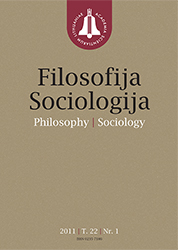Šalies įvykiai ir nusikalstamumas 2010 m. – viešosios informacijos pateikimas žemėlapiuose
Visualisation possibilities of publicly available information on events of 2010 in Lithuania and crime information
Author(s): Giedrė Beconytė, Agnė EismontaitėSubject(s): Social Sciences
Published by: Lietuvos mokslų akademijos leidykla
Keywords: crime rate; spatial analysis; geographic information systems; geoportal
Summary/Abstract: The paper analyses geographic data extracted from textual information on events reported in 2010 in Lithuania, made publicly available on the Internet in the form of daily bulletins by the Police Department under the Ministry of Interior; 3447 events have been mapped using their address information and attributes of event type, date and time. Besides a simple dot map (Figure 2), three informative visualisations are proposed: a density and hot spot map (Figure 3) and clock charts showing the distribution of events by months, weekdays and hours. Dot and density maps should be used for a cartographic representation of any crime statistics instead of meanwhile available charts (Figure 1) which may create a wrong impression about the areas with a high and a low crime rates. Hot (cold) spot maps reveal zones with statistically justified trends of a high (low) concentration of events. Hot and cold zones with the highest probability values are located correspondingly southwest and northeast of Vilnius. Generally, such zones in Lithuania associate with a higher than average event density. The event data are not enough for interpretations, but the results may be interesting as initial materials for the further research. The clock charts (Figures 4 and 5) allow asserting that there are trends of concentration of events in evening hours on weekdays and a more homeogeneous disribution by hours on weekends. The statistics of publicly available events in municipalities of Lithuania was filtered by event type and compared with the official crime statistics. The result depicted in Figure 6 shows that crime statistics is not proportionally reflected in public bulletins across Lithuania. Generally, municipalities with a lower crime rate have a comparatively larger share in the event bulletins than the municipalities with a higher crime rate. Thus, public information may be misleading. The authors propose publishing national crime statistics in the form of density maps at a scale 1:500000 in the Lithuanian spatial information portal www.geoportal.lt. This would allow a comparison of crime statistics with other spatial data that may show a relationship between the crime rate and various other parameters of the social environment.
Journal: Filosofija. Sociologija
- Issue Year: 2011
- Issue No: 4
- Page Range: 405-413
- Page Count: 9
- Language: Lithuanian

